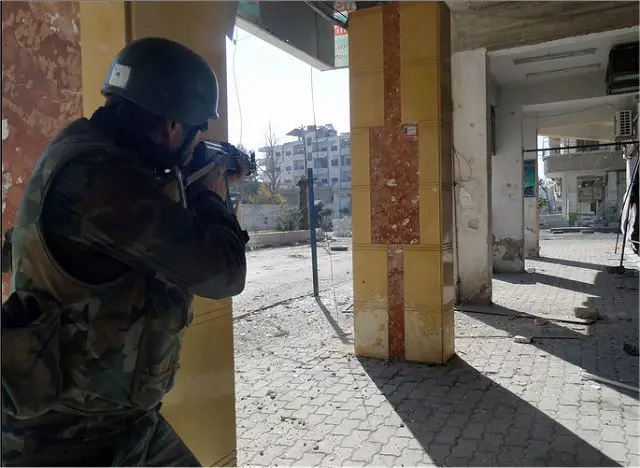| a | |||
Defense News - Syria |
|||
| |
|||
| Thursday, December 6, 2012, 05:31 AM | |||
| Syrian army is ready to use chemical Sarin bombs from bomber aircraft against the rebels. | |||
Syria's
army has loaded bombs with chemical weapons and is awaiting President
Bashar Assad's order to use them on his own people, NBC News reported
Wednesday, December 5, 2012. The military is prepared to deploy the bombs,
which contain the precursor chemicals for the deadly sarin nerve gas,
from dozens of fighter-bombers as soon as Assad gives the order. |
|||
 A Syrian soldier aims his rifle during clashes in the Damascus suburb of Daraya on Sunday. There is frequent fighting in and around Damascus, and residents are increasingly worried about a major battle for the capital. |
|||
Sarin
is classified as a weapon of mass destruction by the United Nations, and
its production and stockpiling is outlawed under the 1993 Chemical Weapons
Convention. |
|||
 Map of suspected production sites of chemical weapons in Syria |
|||
Syria
probably started producing chemical weapons in the 1980s. The original
idea was to deploy them in the event of a war with Israel. Later, the
weapons were only intended to be used as a deterrent. They initially consisted of bombs that were filled with sarin gas and designed to be dropped by aircraft. Warheads for Scud missiles were also subsequently developed, and it's now believed that Syria has roughly 700 of these weapons. According to Israeli intelligence sources, most of the expertise came from the Soviet Union and the former Czechoslovakia, but private companies from Japan and Western Europe also reportedly aided the Syrians. The chemical-weapons depots are among the best-secured locations in all of Syria. Assad's army controls checkpoints on the access roads already kilometers before the gates, and the depots themselves are shielded by two ironclad rings of protective fences and guards. The troops who are responsible for guarding these facilities rank among the regime's loyalest supporters. The two main sites are in the cities of Masyaf and al-Safir, in northern Syria, where chemical munitions are produced and Scud missiles and launch ramps are stationed. Located in a valley some 20 kilometers southeast of Aleppo, the al-Safir complex is said to be the largest and most important chemical-weapons facility in all of Syria. A total of three production plants operate in an area that covers five square kilometers (two square miles). Sprinkler installations, a cooling system and two large underground tanks suggest that al-Safir is no ordinary military base. In its northeastern and northwestern corners, the grounds are protected by Russian-made anti-aircraft missiles, which are supposed to offer comprehensive protection against airstrikes. |
|||
Syrian army is ready to use chemical Sarin bombs from bomber aircraft against the rebels 0612121
- Posted On














